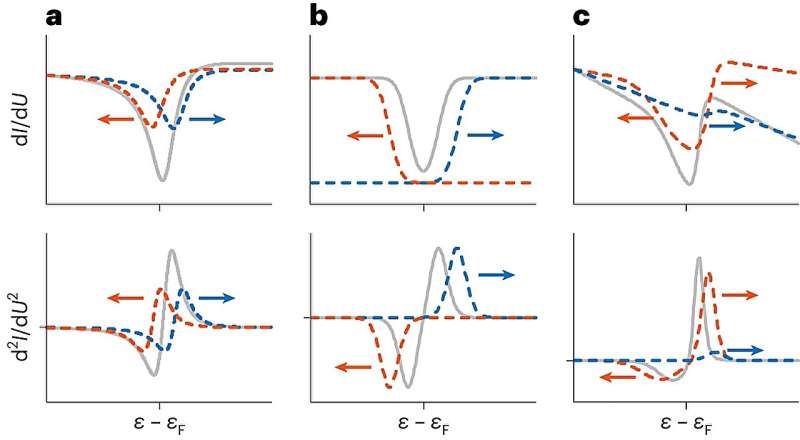This article has been reviewed according to Science X's editorial process and policies. Editors have highlighted the following attributes while ensuring the content's credibility:
fact-checked
proofread
The 'spinaron': New quantum effect challenges the long-held Kondo effect

For the first time, experimental physicists from the Würzburg-Dresden Cluster of Excellence ct.qmat have demonstrated a new quantum effect aptly named the "spinaron." In a meticulously controlled environment and using an advanced set of instruments, they managed to prove the unusual state a cobalt atom assumes on a copper surface.
This revelation challenges the long-held Kondo effect—a theoretical concept developed in the 1960s, and which has been considered the standard model for the interaction of magnetic materials with metals since the 1980s. These groundbreaking findings were published today in Nature Physics.
Ultra-cold and ultra-strong: Pushing boundaries in the lab
Extreme conditions prevail in the Würzburg laboratory of experimental physicists Professor Matthias Bode and Dr. Artem Odobesko. Affiliated with the Cluster of Excellence ct.qmat, a collaboration between JMU Würzburg and TU Dresden, these visionaries are setting new milestones in quantum research.
Their latest endeavor is unveiling the spinaron effect. They strategically placed individual cobalt atoms onto a copper surface, brought the temperature down to 1.4 Kelvin (–271.75° Celsius), and then subjected them to a powerful external magnetic field. "The magnet we use costs half a million euros. It's not something that's widely available," says Bode. Their subsequent analysis yielded unexpected revelations.
"We can see the individual cobalt atoms by usinga scanning tunneling microscope. Each atom has a spin, which can be thought of as a magnetic north or south pole. Measuring it was crucial to our surprising discoveries," explains Bode. "We vapor-deposited a magnetic cobalt atom onto a non-magnetic copper base, causing the atom to interact with the copper's electrons." Researching such correlation effects within quantum materials is at the heart of ct.qmat's mission—a pursuit that promises transformative tech innovations down the road.
Since the 1960s, solid-state physicists have assumed that the interaction between cobalt and copper can be explained by the Kondo effect, with the different magnetic orientations of the cobalt atom and copper electrons canceling each other out. This leads to a state in which the copper electrons are bound to the cobalt atom, forming what's termed a "Kondo cloud."
However, Bode and his team delved deeper in their laboratory. And they validated an alternate theory proposed in 2020 by theorist Samir Lounis from research institute Forschungszentrum Jülich.
By harnessing the power of an intense external magnetic field and using an iron tip in the scanning tunneling microscope, the Würzburg physicists managed to determine the magnetic orientation of the cobalt's spin. This spin isn't rigid, but switches permanently back and forth, i.e. from "spin-up" (positive) to "spin-down" (negative), and vice versa. This switching excites the copper electrons, a phenomenon called the spinaron effect.
Bode elucidates it with a vivid analogy, "Because of the constant change in spin alignment, the state of the cobalt atom can be compared to a rugby ball. When a rugby ball spins continuously in a ball pit, the surrounding balls are displaced in a wave-like manner. That's precisely what we observed—the copper electrons started oscillating in response and bonded with the cobalt atom.
"This combination of the cobalt atom's changing magnetization and the copper electrons bound to it is the spinaron predicted by our Jülich colleague."
The first experimental validation of the spinaron effect, courtesy of the Würzburg team, casts doubt on the Kondo effect. Until now, it was considered the universal model to explain the interaction between magnetic atoms and electrons in quantum materials such as the cobalt-copper duo. Bode quips, "Time to pencil in a significant asterisk in those physics textbooks."
Spinaron and spintronics
In the spinaron effect, the cobalt atom remains in perpetual motion, maintaining its magnetic essence despite its interaction with the electrons. In the Kondo effect, on the other hand, the magnetic moment is neutralized by its the electron interactions.
"Our discovery is important for understanding the physics of magnetic moments on metal surfaces," says Bode. Peeking into the future, such phenomena could pave the way for magnetic information encoding and transportation in new types of electronic devices. Dubbed "spintronics," this could make IT greener and more energy-efficient.
However, Bode tempers expectations when talking about the practicality of this cobalt-copper combination. "We've essentially manipulated individual atoms at ultra-low temperatures on a pristine surface in ultra-high vacuum. That's infeasible for cell phones. While the correlation effect is a watershed moment in fundamental research for understanding the behavior of matter, I can't build an actual switch from it."
Currently, Würzburg quantum physicist Artem Odobesko and Jülich theorist Samir Lounis are concentrating on a large-scale review of the numerous publications that have described the Kondo effect in various combinations of materials since the 1960s. "We suspect that many might actually be describing the spinaron effect," says Odobesko, adding, "If so, we'll rewrite the history of theoretical quantum physics."
More information: Felix Friedrich et al, Evidence for spinarons in Co adatoms, Nature Physics (2023). DOI: 10.1038/s41567-023-02262-6. www.nature.com/articles/s41567-023-02262-6
Provided by Würzburg-Dresdner Exzellenzcluster





















